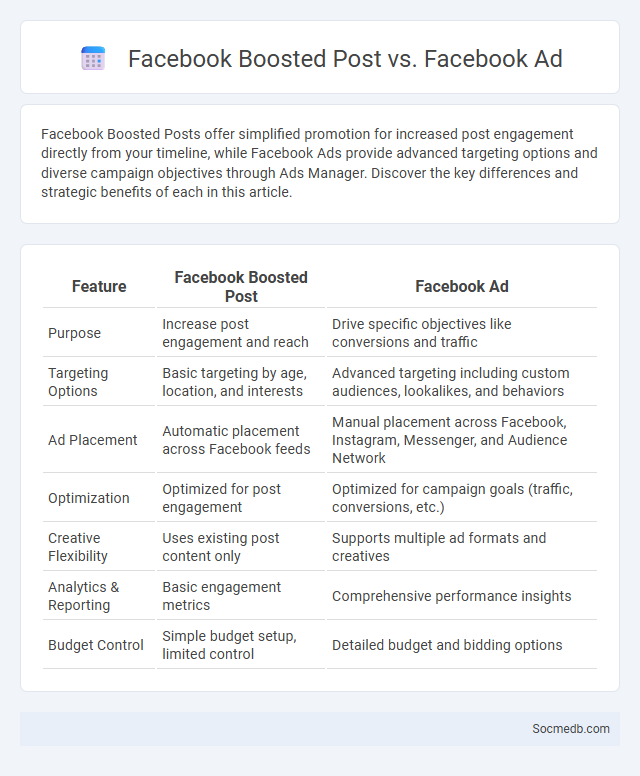
Photo illustration: Facebook Boosted Post vs Facebook Ad
Facebook Boosted Posts offer simplified promotion for increased post engagement directly from your timeline, while Facebook Ads provide advanced targeting options and diverse campaign objectives through Ads Manager. Discover the key differences and strategic benefits of each in this article.
Table of Comparison
| Feature | Facebook Boosted Post | Facebook Ad |
|---|---|---|
| Purpose | Increase post engagement and reach | Drive specific objectives like conversions and traffic |
| Targeting Options | Basic targeting by age, location, and interests | Advanced targeting including custom audiences, lookalikes, and behaviors |
| Ad Placement | Automatic placement across Facebook feeds | Manual placement across Facebook, Instagram, Messenger, and Audience Network |
| Optimization | Optimized for post engagement | Optimized for campaign goals (traffic, conversions, etc.) |
| Creative Flexibility | Uses existing post content only | Supports multiple ad formats and creatives |
| Analytics & Reporting | Basic engagement metrics | Comprehensive performance insights |
| Budget Control | Simple budget setup, limited control | Detailed budget and bidding options |
Facebook Boosted Post vs Facebook Ad: Key Differences
Facebook Boosted Posts primarily increase the visibility of existing organic content by targeting specific audiences, enhancing engagement through likes, comments, and shares. Facebook Ads offer a broader range of customization options, including advanced targeting, diverse ad formats, and detailed campaign objectives like conversions, lead generation, or website traffic. Boosted Posts are simpler for quick promotion, whereas Facebook Ads provide more control and measurement for complex marketing goals.
What is a Facebook Boosted Post?
A Facebook Boosted Post is a paid advertisement feature that amplifies the reach of your organic Facebook posts beyond your current followers. By targeting specific demographics, interests, and locations, it helps you connect with a broader audience to increase engagement, website traffic, or conversions. Using a boosted post allows you to quickly promote content without creating a full ad campaign, making it an efficient way to maximize your social media impact.
Understanding Facebook Ads: How They Work
Facebook Ads operate through a highly targeted algorithm that analyzes user demographics, interests, and behaviors to display relevant advertisements. Advertisers create campaigns using specific objectives such as brand awareness, lead generation, or conversions, allowing precise tracking of performance metrics like click-through rates and return on ad spend. The platform's auction system determines ad placement and cost, optimizing budget allocation to reach the most valuable audience segments effectively.
Boosted Post vs Facebook Ad: Goals and Objectives
Boosted posts on social media primarily aim to increase the visibility and engagement of existing content, targeting a broader audience with minimal setup. Facebook ads offer comprehensive campaign objectives such as lead generation, conversions, and brand awareness, providing advanced targeting, budgeting, and tracking options for measurable results. Choosing between boosted posts and Facebook ads depends on specific marketing goals and desired control over audience segmentation and performance metrics.
Targeting Options: Boosted Posts vs Facebook Ads
Boosted Posts offer simple targeting based on interests, location, and demographics, making them ideal for beginners looking to increase engagement quickly. Facebook Ads provide advanced targeting options like Custom Audiences, Lookalike Audiences, and detailed behavioral data, allowing you to reach specific segments with precision. Choosing the right method depends on your campaign goals, budget, and the level of control you want over your audience targeting.
Budgeting and Cost: Comparing Ad Spend
Social media platforms vary significantly in ad spend efficiency, with Facebook and Instagram often providing lower cost-per-click (CPC) rates compared to LinkedIn or Twitter. Your budgeting should factor in audience targeting precision and campaign objectives, as higher costs may yield better-qualified leads on niche platforms. Monitoring return on ad spend (ROAS) regularly ensures you allocate your budget toward channels delivering the greatest conversions and engagement.
Creative Control and Customization
Social media platforms offer extensive creative control and customization options, enabling users to design personalized profiles, tailor content presentation, and engage audiences uniquely. Features like custom filters, branded templates, and algorithm-driven content curation empower individuals and businesses to maintain consistent visual identities and optimize user interaction. These tools enhance brand storytelling, increase audience engagement, and support targeted marketing strategies across diverse social channels.
Performance Tracking: Metrics & Analytics
Performance tracking on social media relies heavily on key metrics such as engagement rate, reach, impressions, and click-through rate to evaluate the effectiveness of your content. Advanced analytics tools provide insights into audience demographics, behavior patterns, and conversion rates, enabling data-driven decisions to optimize campaigns. By understanding these metrics, you can tailor your strategy to enhance your social media presence and maximize return on investment.
When to Use Boosted Posts vs Facebook Ads
Boosted posts are ideal for increasing the visibility of existing content to a broader audience with minimal setup, perfect for quick engagement and expanding reach among your followers' networks. Facebook Ads provide advanced targeting options, detailed analytics, and multiple campaign objectives, making them better suited for driving specific actions such as conversions or lead generation. You should choose boosted posts for simple promotion and Facebook Ads when precise control over audience and campaign goals is essential.
Pros and Cons: Boosted Posts vs Facebook Ads
Boosted posts on social media offer a quick, easy way to increase the reach of your existing content by targeting followers and similar audiences, resulting in higher engagement with minimal setup. Facebook ads provide advanced targeting options, customizable objectives, and detailed analytics, enabling you to optimize campaigns for conversions or lead generation effectively. You should weigh the simplicity and immediate visibility of boosted posts against the precision and scalability of Facebook ads to determine which suits your marketing goals best.
 socmedb.com
socmedb.com